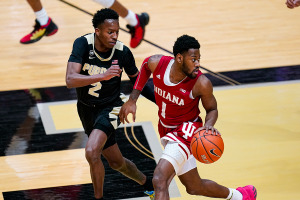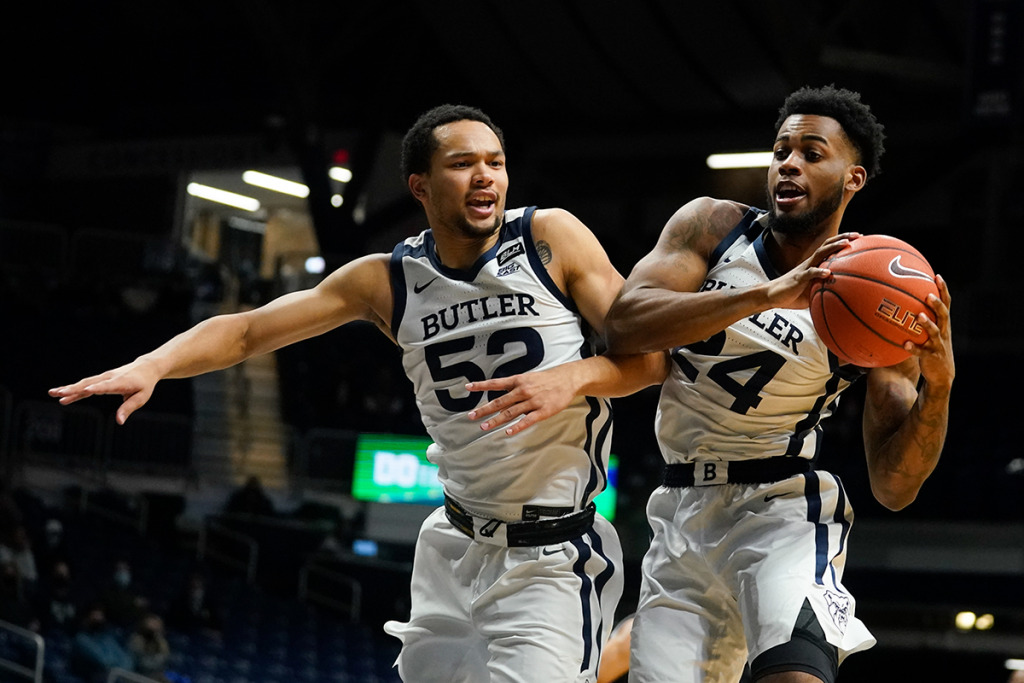Subscriber Benefit
As a subscriber you can listen to articles at work, in the car, or while you work out. Subscribe Now Freedom is a great thing, a cause to die for in fact. But, like everything else, it has its limits. At some point, choice morphs into chaos, and then what do you have?
Freedom is a great thing, a cause to die for in fact. But, like everything else, it has its limits. At some point, choice morphs into chaos, and then what do you have?
The world of college athletics is well on its way to finding out. Boundaries—particularly regarding transfers—that were stifling but also stabilizing are being dismantled piece by piece. The impact remains to be seen, but the future frightens many coaches who believe the rules have sped past the tipping point into a realm that will not serve the best interests of the athlete, the fan and the sport itself.
In Indiana, at least, the changes will be most evident in basketball, it being the most-followed and -understood sport.
“I don’t think it’s fair to college basketball,” Purdue coach Matt Painter said. “It diminishes our game.”
“It’s beautiful, isn’t it?” Indiana University assistant basketball coach Dane Fife said with a touch of sarcasm. “But nobody wants to talk about the unintended consequences.”
People will be talking about them soon enough, because the fallout is already happening and will be devastating to some programs. It likely will benefit some, as well, but the result looks to be a dark landscape full of potholes.
The NCAA’s primary legislative body, the Division I Council, approved a measure on April 15 that granted college athletes one-time freedom to transfer to another school and have immediate eligibility. Although some restrictions remain, such as requiring athletes to be academically eligible at their original school and not allowing them to transfer without penalty during the season, the change brings a version of free agency that surpasses that of professional levels. Pro athletes, at least, are bound by contracts, many that cover multiple years and some that include no-trade clauses.
College athletes now have more freedom than ever and will flex it often. Purdue’s football program lost highly regarded tight end Maliq Carr, who, after just one season as a Boilermaker, announced his intention to transfer to Michigan State. Indiana lost guards Al Durham (Providence) and Armaan Franklin (Virginia) and center Joey Brunk (Ohio State) but gained guards Xavier Johnson from Pittsburgh and Parker Stewart from UT-Martin. It also will get guard Tamar Bates, who opted out of his commitment to Texas because of a coaching change there. Butler, which has benefited greatly from incoming transfers in recent years, lost forward Markeese Hastings to Western Michigan, which had six of its players enter the portal.
Easy come, easy go. Get used to it.
Same for all
There are positives to lifting transfer restrictions. For one, it levels the playing field. Previously, only athletes in football, men’s and women’s basketball, baseball and ice hockey had to sit out a year upon transferring. Now, the rules apply to everyone. It also removes the valid argument that the previous rule, which began in the 1960s, was unfairly restrictive, even exploitive—particularly when coaches can change schools at the drop of an extra dime. And while it discouraged young athletes from making an impulsive decision based on a temporary frustration, such as playing time and homesickness, it failed to recognize the legitimate reasons some might have for changing schools.
Sometimes, athletes are misled in the recruiting process about their opportunity for playing time or their role. Sometimes, better players are recruited after them, leaving them stuck on the bench. Sometimes, an event in their personal lives makes it more desirable to attend a school closer to home. Sometimes, the coach who recruited them leaves and they wind up playing for one less suitable.
Besides, non-athletes switch schools whenever they want for whatever reason, and people often change jobs in search of a better situation, so why not a college athlete? No-fault divorces have been in effect since the 1960s, allowing a spouse to end a marriage for the simple reason of incompatibility, so why can’t a college athlete end an incompatible relationship?
The down side
All valid points, but this is where Fife’s “unintended consequences” come into play. Governmental deregulation sounds good on the surface, but what if it leads to increased pollution? That’s what coaches are fearing: more pollution in their atmosphere.
If athletes are overly empowered, will coaches become reluctant to discipline them for their own good out of fear they will leave? Will unhappy underclassmen be awarded unwarranted playing time to soothe their egos? Will coaches begin declaring their personnel needs in postgame press conferences to put out the word to potential transfers? Will they scout players on other teams in search of someone to fill those needs and recruit them?
Of course they will.
“You’re going to have staffs recruit people in the [postgame] handshake line,” Painter said.
You also might have college athletes banding together to create their own “super teams,” as some NBA players have done. College athletes today, particularly in basketball, are often acquainted with those from other schools because of AAU competition and social media, so players could arrange to transfer to the same school and play together immediately. What coach trying to keep his or her job wouldn’t take them if they were good enough? But what would that coach have to sacrifice in terms of authority and team play?
And, perhaps most of all: How can coaches establish a lasting culture if they can’t keep core players together for long?
The unstable foundation of today’s college athletic structure is on bold display in the NCAA’s transfer portal, an online tool implemented in October 2018 to provide a transparent way for Division I, II and III athletes to state their interest in transferring and for coaches to identify them. Athletes can withdraw from the portal and stay at their current school, as some IU basketball players did after Mike Woodson was hired, but most move on if given the chance.
As of Monday, 17,700 athletes had placed their names in the portal, including 2,954 in football, 1,452 in men’s basketball and 1,007 in women’s basketball. That’s a lot of unhappy athletes seeking greener grass, and the numbers will only grow.
‘Adversity is important’

Most coaches agree a transfer is sometimes the best option for all involved, and examples abound. Small-town native Larry Bird left IU before practice began his freshman year because he felt out of place socially and hitchhiked home. It worked out all right for him at Indiana State. Dave Shepherd, Indiana’s Mr. Basketball in 1970, left IU after his sophomore year because he wound up playing for a different coach (Bob Knight) than the one who had recruited him (Lou Watson) and no longer fit the system. He finished at Mississippi State, earning all-conference honors. Kyle Macy, Mr. Basketball in 1975, left Purdue after a successful freshman season because he felt out of place. He finished at Kentucky, where he earned All-America honors for a national championship team.
Those players all were willing to sit out a year, though, and benefited from that experience to improve their bodies, skills and maturity.
It doesn’t always work out that way, however. Many athletes simply take their shortcomings to the next school and repeat them. Coaches fear many of them will miss out on the opportunity to learn how to confront challenges or accept a role for the greater good—skills that can be applied in the adult world outside of basketball. Toward that end, many coaches would like for the rules prohibiting transferring without penalty to go into effect only after an athlete has played two seasons to reduce the possibility of an overly impulsive decision.
“No matter where you go, you normally get to a crossroads and wonder, ‘Is this for me?’” said Painter, who is a member of five National Association of Basketball Coaches boards or committees, including a subcommittee that addresses transfers.
“There’s going to be adversity. Sometimes [a transfer] is the right thing and it turns out to be a positive thing, but … adversity is important. When you push through tough times, it helps you.”
Adds Fife: “It’s a great learning environment in most programs. If you do it right [as an athlete], you’ve got your foot in the door for having the success you dream of. You’re a step ahead of most people.”
Painter admits to questioning some of Purdue coach Gene Keady’s decisions as a freshman, and he wasn’t happy with his minimal playing time. He averaged less than a point per game as a freshman.
“I didn’t like everything Coach Keady said to me at the time, but he never lied to me,” Painter said.
He soon realized he wasn’t athletic enough to become a star player in the Big Ten but stuck it out and became a full-time starter his senior season. The loyalty he showed to Keady and the assistant coaches was rewarded with their help in arranging coaching opportunities for him after graduation. It’s highly unlikely he would be coaching at Purdue today if he had transferred to a smaller school for more playing time.
‘Too much chaos’
Former Purdue center Steve Scheffler stands tall as a role model for a young athlete overcoming adversity. He arrived at Purdue in 1986, having been recruited more heavily for football than basketball. The coaches passed on redshirting him because they didn’t want to waste a fifth year’s scholarship, and after he averaged just 1.5 points as a frightened freshman, hints were dropped that maybe football was the better option for him.
Scheffler got a primary backup role as a sophomore only because a teammate, Jeff Arnold, was kicked off the team for disciplinary reasons. He gradually improved and wound up earning the media vote for the Big Ten’s Most Valuable Player award as a senior in 1990 and playing seven seasons in the NBA.
He said he never seriously considered transferring because it would have seemed disloyal. He knows not every athlete today will share that outlook, however. Whereas he lacked confidence as a young player, many today have an overabundance of it.
“The rule is going to cause too much chaos,” Scheffler said. “You have the ‘I’m entitled-to-everything kids,’ the ‘I’m-the-greatest-because-my-parents-always-told-me-that-and-now-the-coaches-aren’t-telling-me-that-so-I’m-going-to-leave’ kids.”
Mid-major pain
One of the greatest fears among coaches is that the eased transfer rules will have a devastating impact on mid-major programs. Kids who excel as a freshman or sophomore at a school such as Ball State or Indiana State, for example, will be more tempted than ever to jump to a major program if they don’t have to sit out a season.
Painter had sent a communication to the entire NABC membership opposing the new transfer rule largely because of this factor, and Fife agrees.
“Mid-majors are going to be decimated because of the food chain,” Fife said. “Take a team that was league champion. One player is good enough for the blueblood programs, so he transfers. Another can play for a middle-of-the-pack [major program], so he transfers, too. And the other player who had gotten good is graduating. Now what are they going to do?”
Jack Owens, a graduate of Indianapolis Washington High School, wonders, too. As the head coach at Miami of Ohio the past four seasons, the threat of his better players bailing out increases.
“It’s going to be a new way of life for us as coaches,” Owens said. “Hopefully, the relationships you build with your players are long-lasting. There’s no telling what can happen. It’s going to take a year or two for it to run its course and see where we stand.”
But wait, there’s more. The NCAA also has adopted rules for Name, Image and Likeness (NIL) going into effect Aug. 1 that permit athletes to be compensated for autographs, personal appearances, product promotion and the use of their image in marketing. That means financial opportunities could prove to be another incentive for athletes to transfer.
It could affect recruiting, too. It’s not much of a stretch to imagine an athlete being told he (or she, but probably he) can earn thousands of dollars, perhaps hundreds of thousands, by enrolling at a major program with a large and rabid fan base.
“If you don’t see that happening, you’re nuts,” Fife said.
No question, college athletic administrators have let the genie out of the bottle. What happens next is difficult to predict, but “nuts” seems a good place to start.•
__________
Montieth, an Indianapolis native, is a longtime newspaper reporter and freelance writer. He is the author of three books: “Passion Play: Coach Gene Keady and the Purdue Boilermakers,” “Reborn: The Pacers and the Return of Pro Basketball to Indianapolis,” and “Extra Innings: My Life in Baseball,” with former Indianapolis Indians president Max Schumacher.
Please enable JavaScript to view this content.




These rules are going to create a huge can of worms. When you receive something of value ( a college scholarship) there are trade offs. If a coach leaves or is fired absolutely players should be allowed to transfer but to just do it on a whim? Chaos is just around the bend.
I can see the problems in basketball with good mid-major players transferring to the Power 5 schools. But I can also see the reverse happening with football – especially in the non-skilled positions. If you are a starter at a mid-major school, why transfer to a Power 5 school where your playing time likely be limited. Also if your playing time is limited at a Power 5 school, why not transfer to a mid-major where you will likely be a starter. Pro scouts will find you no matter where you are so long as you are on the field and showcasing what you can do. Just look at the pro team rosters. All have players from mid-majors (and some from even smaller schools). If you intend on a pro career, you need playing time.